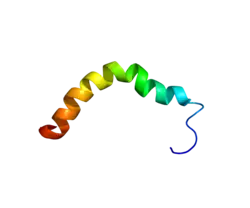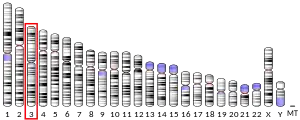UCN2
Urocortin-2 is a protein that in humans is encoded by the UCN2 gene.[5][6]
| UCN2 | |||||||||||||||||||||||||||||||||||||||||||||||||||
|---|---|---|---|---|---|---|---|---|---|---|---|---|---|---|---|---|---|---|---|---|---|---|---|---|---|---|---|---|---|---|---|---|---|---|---|---|---|---|---|---|---|---|---|---|---|---|---|---|---|---|---|
 | |||||||||||||||||||||||||||||||||||||||||||||||||||
| |||||||||||||||||||||||||||||||||||||||||||||||||||
| Identifiers | |||||||||||||||||||||||||||||||||||||||||||||||||||
| Aliases | UCN2, SRP, UCN-II, UCNI, UR, URP, urocortin 2 | ||||||||||||||||||||||||||||||||||||||||||||||||||
| External IDs | OMIM: 605902 MGI: 2176375 HomoloGene: 50048 GeneCards: UCN2 | ||||||||||||||||||||||||||||||||||||||||||||||||||
| |||||||||||||||||||||||||||||||||||||||||||||||||||
| |||||||||||||||||||||||||||||||||||||||||||||||||||
| |||||||||||||||||||||||||||||||||||||||||||||||||||
| |||||||||||||||||||||||||||||||||||||||||||||||||||
| |||||||||||||||||||||||||||||||||||||||||||||||||||
| Wikidata | |||||||||||||||||||||||||||||||||||||||||||||||||||
| |||||||||||||||||||||||||||||||||||||||||||||||||||
This gene is a member of the sauvagine/corticotropin-releasing factor/urotensin I family. It is structurally related to the corticotropin-releasing factor (CRF) gene and the encoded product is an endogenous ligand for CRF type 2 receptors. In the brain it may be responsible for the effects of stress on appetite. In spite of the gene family name similarity, the product of this gene has no sequence similarity to urotensin II.[6]
References
- GRCh38: Ensembl release 89: ENSG00000145040 - Ensembl, May 2017
- GRCm38: Ensembl release 89: ENSMUSG00000049699 - Ensembl, May 2017
- "Human PubMed Reference:". National Center for Biotechnology Information, U.S. National Library of Medicine.
- "Mouse PubMed Reference:". National Center for Biotechnology Information, U.S. National Library of Medicine.
- Hsu SY, Hsueh AJ (Apr 2001). "Human stresscopin and stresscopin-related peptide are selective ligands for the type 2 corticotropin-releasing hormone receptor". Nat Med. 7 (5): 605–11. doi:10.1038/87936. PMID 11329063. S2CID 22916906.
- "Entrez Gene: UCN2 urocortin 2".
Further reading
- Hauger RL, Grigoriadis DE, Dallman MF, et al. (2003). "International Union of Pharmacology. XXXVI. Current status of the nomenclature for receptors for corticotropin-releasing factor and their ligands". Pharmacol. Rev. 55 (1): 21–6. doi:10.1124/pr.55.1.3. PMID 12615952. S2CID 1572317.
- Florio P, Torres PB, Torricelli M, et al. (2006). "Human endometrium expresses urocortin II and III messenger RNA and peptides". Fertil. Steril. 86 (6): 1766–70. doi:10.1016/j.fertnstert.2006.05.041. PMID 17074339.
- Imperatore A, Florio P, Torres PB, et al. (2006). "Urocortin 2 and urocortin 3 are expressed by the human placenta, deciduas, and fetal membranes". Am. J. Obstet. Gynecol. 195 (1): 288–95. doi:10.1016/j.ajog.2005.12.048. PMID 16626608.
- Isfort RJ, Wang F, Tscheiner M, et al. (2006). "Modifications of the human urocortin 2 peptide that improve pharmacological properties". Peptides. 27 (7): 1806–13. doi:10.1016/j.peptides.2006.01.003. PMID 16476507. S2CID 41513209.
- Czimmer J, Million M, Taché Y (2006). "Urocortin 2 acts centrally to delay gastric emptying through sympathetic pathways while CRF and urocortin 1 inhibitory actions are vagal dependent in rats". Am. J. Physiol. Gastrointest. Liver Physiol. 290 (3): G511–8. doi:10.1152/ajpgi.00289.2005. PMID 16223946. S2CID 10157248.
- Gerhard DS, Wagner L, Feingold EA, et al. (2004). "The status, quality, and expansion of the NIH full-length cDNA project: the Mammalian Gene Collection (MGC)". Genome Res. 14 (10B): 2121–7. doi:10.1101/gr.2596504. PMC 528928. PMID 15489334.
- Chang CL, Hsu SY (2005). "Ancient evolution of stress-regulating peptides in vertebrates". Peptides. 25 (10): 1681–8. doi:10.1016/j.peptides.2004.05.022. PMID 15476935. S2CID 25716793.
- Karteris E, Hillhouse EW, Grammatopoulos D (2004). "Urocortin II is expressed in human pregnant myometrial cells and regulates myosin light chain phosphorylation: potential role of the type-2 corticotropin-releasing hormone receptor in the control of myometrial contractility". Endocrinology. 145 (2): 890–900. doi:10.1210/en.2003-1210. PMID 14592950.
- Chanalaris A, Lawrence KM, Stephanou A, et al. (2004). "Protective effects of the urocortin homologues stresscopin (SCP) and stresscopin-related peptide (SRP) against hypoxia/reoxygenation injury in rat neonatal cardiomyocytes". J. Mol. Cell. Cardiol. 35 (10): 1295–305. doi:10.1016/S0022-2828(03)00244-X. PMID 14519439.
- Strausberg RL, Feingold EA, Grouse LH, et al. (2003). "Generation and initial analysis of more than 15,000 full-length human and mouse cDNA sequences". Proc. Natl. Acad. Sci. U.S.A. 99 (26): 16899–903. Bibcode:2002PNAS...9916899M. doi:10.1073/pnas.242603899. PMC 139241. PMID 12477932.
- Lewis K, Li C, Perrin MH, et al. (2001). "Identification of urocortin III, an additional member of the corticotropin-releasing factor (CRF) family with high affinity for the CRF2 receptor". Proc. Natl. Acad. Sci. U.S.A. 98 (13): 7570–5. Bibcode:2001PNAS...98.7570L. doi:10.1073/pnas.121165198. PMC 34709. PMID 11416224.
- Reyes TM, Lewis K, Perrin MH, et al. (2001). "Urocortin II: a member of the corticotropin-releasing factor (CRF) neuropeptide family that is selectively bound by type 2 CRF receptors". Proc. Natl. Acad. Sci. U.S.A. 98 (5): 2843–8. Bibcode:2001PNAS...98.2843R. doi:10.1073/pnas.051626398. PMC 30227. PMID 11226328.
This article is issued from Wikipedia. The text is licensed under Creative Commons - Attribution - Sharealike. Additional terms may apply for the media files.



